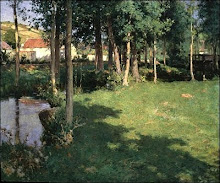Constant Troyon, A Clump of Trees, c.1860
George Inness, The Brook.
These works by Constant Troyon (top) and George Inness, make use of the golden light of dusk to suffuse the scenes with a sense of mystery. Warm golden hues - yellows sometimes with a touch of orange and red - are the perfect foil for dark grey-green foliage, creating a mood of soothing harmony.
The American landscape painter George Inness was so influential that he is often called "the father of American landscape painting".
In his mature period, Inness discovered the spiritual writings of the Swedish mystic, Emanuel Swedenborg. The late paintings are poetic and mystical, with landscape views that are more intimate and personal, and a handling of shapes that is more abstract and nebulous than the earlier, more descriptive paintings.
In a published interview, Inness maintained that "The true use of art is, first, to cultivate the artist's own spiritual nature." His abiding interest in spiritual and emotional considerations did not preclude Inness from undertaking a scientific study of color, nor a mathematical, structural approach to composition: "The poetic quality is not obtained by eschewing any truths of fact or of Nature...Poetry is the vision of reality."-Wikipedia
The glowing golden skies in these works would probably have been created by applying transparent glazes of a warm yellow over a white underpainting.

Geroge inness, The Monk, 1873.
Maple Screen, Hasegawa Tohaku.
It's possible that Inness was influenced by seeing the gold leaf backgrounds of Japanese folding screens (Byōbu), or it may have just been the symbolic association gold has with the Eternal.





.jpg)













+1900.bmp)